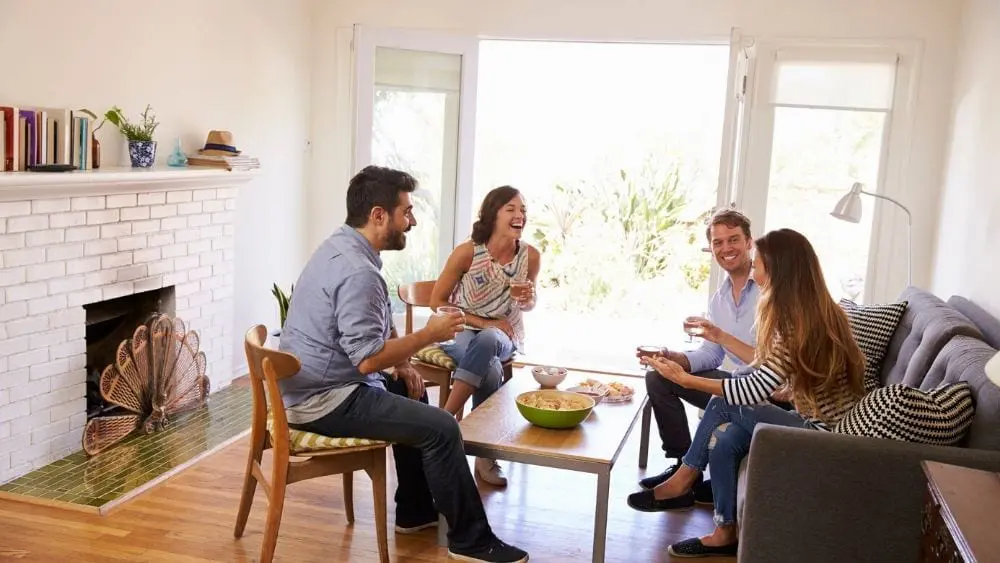
Some homes are great for guests. Others aren’t.
If you want your newly built home to be a place your guests will love to visit, you’ll need to make some guest-friendly choices when you pick your floor plan and other design elements.
Picking the Perfect Floorplan
The first consideration—and it’s a huge one—is how open you’d like your floor plan to be. An open plan with a kitchen island is great choice for entertaining because it allows you to prepare food and beverages while you socialize with your guests.
“The cook or chef in the family doesn’t have to choose to be in the family room or the kitchen. They can carry on a conversation between the rooms,” says Ben Rutt, director of marketing at Keystone Custom Homes in Lancaster, Pa.
An open plan can feel intimate or accommodate a crowd.
“Larger common areas are more open, so you can have that flexibility. It could be just you and your partner or you could have, say, 10 or 12 guests in that same area,” says Lisa Pickell, president of Orren Pickell Building Group in Wilmette, Ill.
To enhance the perception of openness, use the same flooring in the areas that you want to combine. Whether it’s hardwood, vinyl, tile, stone or some other material, consistency will help to delineate the space, Rutt says.
Do You Need Formal or Informal Space
A separate formal dining room has been on the decline in new homes, but may be making a comeback as people rediscover the joy of entertaining at home.
Pickell recalls one family that hosted a sit-down dinner for 20 to 30 guests every Friday evening.
“A dining room that routinely fits that many people might not be for everyone, but for that family and the way they entertain, it was very important to them,” Pickell says.
The key to making these decisions when you buy your home is to think about how you plan to entertain, who your guests will be and what you’ll need for them to feel comfortable.
The general rule for guest-friendly spaces is “the more informal, the more open and the more formal, the more closed,” Pickell says.
Indoors Meets Outdoors
When you design a home for guests, a good indoor-outdoor flow can help.
Rutt recommends that you include a partially covered patio that can be used in fine or inclement weather and a fire pit or fireplace that can function as a gathering spot. If those upgrades aren’t in your initial budget, you can add them after you move into your home.
“You want to plan ahead and think about the space and what you want the space to be,” Rutt advises.
A “cool feature,” to use Rutt’s description, that Keystone offers is a double-sided see-through indoor-outdoor fireplace that’s built into an exterior wall so it can be used in the living area or on the patio.
“It’s natural human instinct to gather around the fireplace,” Rutt says.
Consider Adding Extra Guest Bedrooms
Guests who stay overnight need privacy, especially in their bedrooms and bathrooms.
The best option is an en-suite (or incorrectly, ensuite) bathroom, which can be accessed only through one bedroom. (The term en suite literally means “in the suite.”)
“In a perfect world – you can afford whatever you want – all of the bedrooms would be en suite,” Pickell says.
If that’s not an option due to cost or space constraints, the next-best choice could be a Jack-and-Jill bathroom, which has two doors that open to separate bedrooms. The name comes from the nursey rhyme, but the design is better known from The Brady Bunch, an early ’70s sitcom about a family whose six children shared two bedrooms and one Jack-and-Jill bathroom.
The best Jack-and-Jills for guests have a shower, toilet and two vanities, so guests have separate spaces for their toothbrush and other personal items. Extra towel racks are a plus, too.
Whether every bedroom should be wired for a TV is, “a sticky subject,” Pickell says.
Some people favor in-bedroom TVs because they allow guests to continue their usual morning or evening routine in their private space. Others feel that visits are a time for guests to spend together and that personal TVs tend to diminish opportunities for guests to socialize with one another.
Who Will Sleep Where?
Where your guest bedrooms are located within your home also matters.
Having at least one bedroom, preferably with an en-suite bathroom, on the main level gives guests easier access to their space and more privacy.
“Guests can stay on the main level without having to walk up and down stairs or interfere with the family bedrooms or bathrooms upstairs,” says Jonathan Faccone, real estate developer and investor at Halo Homebuyers in Bridgewater, N.J.
If you expect to host children overnight, you might want a larger room, perhaps a finished basement, with two or three sets of bunkbeds or one set of bunks and a separate bed with a trundle bed that pulls out from under it.
You can also create special sleeping spaces just for small visitors.
“Kids love little places in the rafters or under the stairs,” Pickell says. “Even if you don’t have a massive room, you can still create that fun, inviting environment for your little guests.”
Put all these tips together and your guests will want to visit your home as often as you’re ready and willing to welcome them.

Marcie Geffner is an award-winning freelance reporter, writer and editor in Ventura, California. In the last decade, she has penned more than 1,000 published stories about residential and commercial real estate, banking, credit cards, computer security, health insurance and small business, among other subjects. Editors describe her as “detail-driven,” “conscientious,” “smart” and “incredibly versatile.” Her award-winning reporting has been lauded as “rock solid,” “spot-on relevant,” “informative,” “engaging,” “interesting” and “nuanced.” Her stories have been cited in seven published nonfiction books and two U.S. Congressional hearings.
Prior to her freelance career, Geffner was senior editor of California Real Estate magazine. Later, she became managing editor of Inman.com, an independent real estate news website. She also has prior employment experience in technical writing, corporate communications and employee communications. She received a bachelor’s degree in English with high honors from UCLA and master’s degree in business administration (MBA) from Pepperdine University in Malibu, California. She enjoys reading, home improvement projects and watching seagulls at the beach.
 How to Select the Right Financial Institution for Your New Home
How to Select the Right Financial Institution for Your New Home